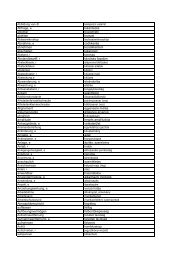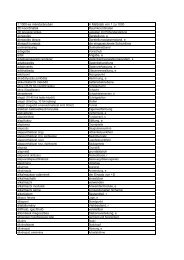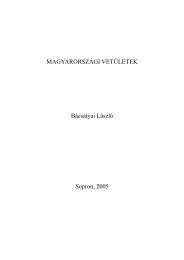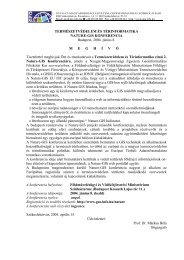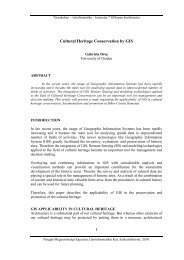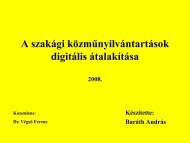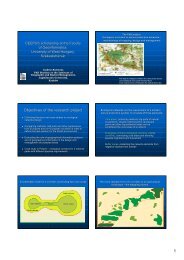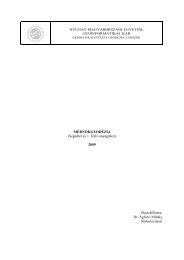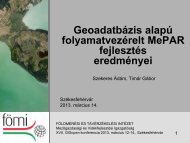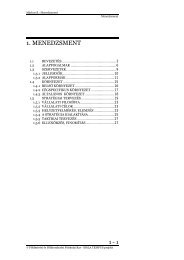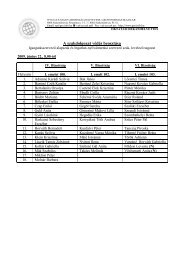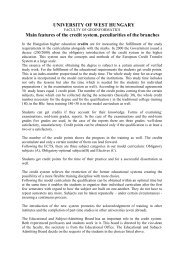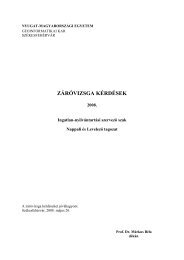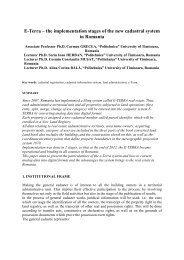Nature-GIS White Paper
Nature-GIS White Paper
Nature-GIS White Paper
You also want an ePaper? Increase the reach of your titles
YUMPU automatically turns print PDFs into web optimized ePapers that Google loves.
II.4<br />
IONIC Software S.A.<br />
<strong>Nature</strong>-<strong>GIS</strong><br />
A European thematic network for Protected Areas/<strong>Nature</strong> Preservation<br />
and Geographical Information<br />
Project IST-2001-34641<br />
<strong>Nature</strong>-<strong>GIS</strong> <strong>White</strong> <strong>Paper</strong><br />
IONIC Software is a privately held Belgian company committed to providing<br />
fully interoperable, enterprise-class products for the publishing, discovery,<br />
access, integration, and application of corporate spatial data and services, in<br />
support of core business functions. IONIC has a vision of a world driven by<br />
standards-based interoperability, leading to reduced cost of ownership. IONIC’s mission is to leverage<br />
its extensive experience to create and deliver the best suite of commercial off the shelf (SCOTS) Java<br />
component products. Orienting enterprise data in space and time, and integrating spatial logic into<br />
enterprise decision-making, the IONIC Java Component Suite provides breakthrough business<br />
performance gains across an array of industries.<br />
IONIC is the first company worldwide to deliver as COTS products operational Web Feature Server to<br />
interact with GML data. These products are deployed since 2 years and successfully used in operation<br />
by ESA (European Space Agency) for Earth Observation application, by the Norwegian Mapping<br />
Authority as the spatial baseline within the national e-Gov Program (e-Norge) and more recently by a<br />
major world-wide Telecom Operator as their core infrastructure for offering Location Based Services<br />
(LBS) to 3G mobile phone subscribers.<br />
IONIC technology is designed in conformance with OGC, ISO and W3C directions; IONIC components<br />
are built to run on powerful J2EE Application Servers, on any hardware platform, and to scale to very<br />
large volumes of spatial data as well as large number of simultaneous users. IONIC has developed<br />
Java components on server side (Servlets, EJBs, business logic components, developer tools, and<br />
more) as well as a client side development toolkit to provide developers with the most advanced<br />
commercial Java components to create geo-enabled business solutions. The IONIC COTS are wellknown<br />
for being reliable, scalable, robust, ready-to-use and easy to integrate or configure when<br />
necessary. In addition, IONIC has created a set of GML<br />
Tools - as Java components - that can process XML Application schema and convert any kind of data<br />
to/from GML data, directly from typical sources like Oracle 8i/9i database, <strong>GIS</strong> files.<br />
II.5<br />
University of Evora<br />
The Centre of Applied Ecology is a research body within the University of Ėvora<br />
(Portugal). Research is divided into four areas, each of which is led by a group of<br />
researchers with their own laboratory: Biological Cartography; Applied Entomology;<br />
Freshwater Ecology; and Marine Ecology. Our lab – Biological Cartography - is<br />
concerned with three broad research questions:<br />
1) ‘why do species occur where they do?’;<br />
2) ‘what environmental and geographical factors affect persistence and extinction of species within a<br />
given area?’;<br />
3) ‘where should conservation effort be directed to, given information from questions 1 and 2?’<br />
We favour multi-species analysis; cross taxon-comparisons; and the development of statistical<br />
techniques to test hypothesis about current and future distributions of organisms. We are interested in<br />
exploring indicator relationships and short-cut approaches to the conservation of biological diversity.<br />
We explore <strong>GIS</strong> capabilities in the study of macroecological patterns and processes. We hope that<br />
developing methods and improving our understanding about scale in Ecology will help us to design<br />
better strategies for conserving biological diversity.<br />
13



